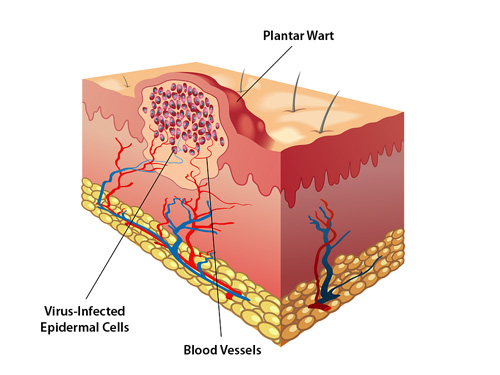
The sometimes unsightly wart that most often pops up on your hand is nothing more than a skin growth that spawns from having some form of the human papillomavirus, also known as HPV.
This form of HPV impacts the top layer of your skin. It typically gets in your body through broken skin, i.e. an open wound or other type of scrape or cut.
When the virus enters, it forces the top layer of skin to grow more rapidly than normal, and the end result is a wart.
Common warts are mostly found on your hands, but they can actually grow anywhere on your body. Other types of warts grow other places, like plantar warts, for example, which grow on the soles of your feet.
How do warts spread?
Unfortunately, warts spread pretty easily. It happens through direct contact with HPV. If you’re already infected, you can double-infect yourself – in a manner of speaking – if you touch the wart and then touch another part of your body.
It’s easy to spread to other people as well by sharing the following items:
- Towels
- Razors
- Other personal items
You might not notice a wart right after you come into contact with human papillomavirus. In fact, it can take months before a wart forms. It’s also important to note that some people are just more prone to warts than others.
What are the symptoms of a wart?
How do you know if you have a wart? Warts can look a variety of different ways:
- They can be bumpy and rough on the surface.
- They can be flat and smooth.
- They can have dark spots in the center because of the tiny blood vessels that grow into the wart’s core to make sure it has a blood supply.
If you don’t know whether you have a wart, you can see your doctor, who will usually be able to tell if it’s a wart just by looking at it.
If not, the doctor could cut a small sample of the wart to give it a closer look under a microscope. That’s only done if the doctor isn’t sure if it’s a wart, or if one of the following conditions occur:
- The skin growth is darker than the skin around the growth.
- There’s an irregular patch on the skin.
- The growth bleeds.
- The growth is large and growing quickly.
How do you treat a wart?
The good news is that warts usually don’t hurt, but if it finds its home in a part of your body where you apply pressure (a finger or the bottom of your foot, for example), the wart can turn painful really fast.
Most warts don’t need to be treated. They’ll go away on their own within a few months.
Here are some treatments available if you decide to treat your wart:
- Salicylic acid or duct tape. Both are available without a prescription.
- Applying a stronger medicine on the wart, or getting a shot of medicine inside the wart.
- Freezing the wart (cryotherapy).
- Removing the wart with surgery (electrosurgery, curettage, laser surgery).
Even if you treat and destroy the wart, that doesn’t mean it won’t come back to haunt you. Most treatments kill the wart, but not the virus that causes the wart.
If you have any questions about your wart, stop by an Urgent Care clinic today.
